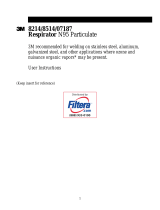
3M™ Product Name
Personal Safety Division
3M Center, Building 235-2W-70
St. Paul, MN 55144-1000
3M PSD products are
occupational use only.
© 3M 2017. All rights reserved.
3M is a trademark of 3M Company and affiliates.
Used under license in Canada.
All other trademarks are property
of their respective owners.
Please recycle. Release 2, October 2017
In United States of America
Technical Service: 1-800-243-4630
Customer Service: 1-800-328-1667
3M.com/workersafety
In Canada
Technical Service: 1-800-267-4414
Customer Service: 1-800-364-3577
3M.ca/Safety
Description
Smoke, ash and other small particulates can be present in the air due to wildfires, air pollution and volcanoes. Particles that are
small enough to remain airborne are also small enough to be inhaled. Inhalation of these types of particles can cause a variety
of effects ranging from irritation and discomfort to exacerbation of asthma. Individuals with pre-existing conditions, such as
heart or lung disease, or smokers, have a greater chance of experiencing additional or more severe symptoms.
There are several ways to help protect yourself against inhalation of particles related to ash, smoke or air pollution. First, the
best way is to try to avoid exposure to these particulates and their sources. If that is not possible, then you should follow the
advice of your local health authority or a national health agency, such as the US Centers for Disease Control and Prevention
(CDC). The US CDC lists a number of strategies to help reduce exposure to smoke and ash, including use of a properly worn
N95 respirator.
The CDC emphasizes the selection of an approved respirator over a non-approved “comfort” or “dust” mask. Additionally, the
CDC offers further resources regarding effective respirators and their proper use.
http://www.cdc.gov/niosh/npptl/topics/respirators/disp_part/RespSource.html
http://www.cdc.gov/niosh/docs/2003-144/
N95 respirators are particulate respirators and will filter out airborne particulates. Wildfires, volcanoes and air pollution all
produce airborne particulates, but they can also release gases and vapors. N95 respirators do not filter out gases and vapors.
Therefore, a different type of respirator must be selected for fire-fighting or when one needs respiratory protection very close
to the source of smoke, ash or air pollution.
For more information on the use of N95 respirators for exposures to smoke and ash during wildfires and cleanup please see,
3M Technical Data Bulletin: Personal Protective Equipment During Cleanup of Residential Wildfire Debris
.
Individuals using respiratory protection should always carefully read and follow the User Instructions for the model of respirator
they are using. It is very important that the user be clean-shaven and follow the donning instructions exactly to get a good seal
between the respirator and the face. Users with underlying heart or lung conditions should consult a physician prior to use.
The respirator manufacturer and/or their local health authority should be contacted with any further questions.
In addition to respiratory protection, people exposed to smoke, ash or air pollution may also want to consider eye protection,
such as tight-fitting goggles.
Cleaning up after a fire or volcano may result in additional exposures beyond smoke and ash. The CDC, California Department
of Health, other health agencies and 3M offer additional resources regarding smoke and ash exposure and clean up after
wildfires.
http://emergency.cdc.gov/disasters/wildfires/responders.asp
References
• http://emergency.cdc.gov/disasters/wildfires/facts.asp
Help Protect Yourself From Airborne Exposures to Smoke, Ash and
Particulate Air Pollution
Technical Bulletin
Release 2, October 2017
-
 1
1
3M 8511HB2-C User guide
- Type
- User guide
- This manual is also suitable for
Ask a question and I''ll find the answer in the document
Finding information in a document is now easier with AI
Related papers
-
3M Disposable Respirators DL DPR Operating instructions
-
3M 8511HA1-C-PS Installation guide
-
3M Disposable Respirators DL DPR Operating instructions
-
3M Disposable Respirators DL DPR Operating instructions
-
3M 7800S User manual
-
3M Disposable Respirators DL DPR Operating instructions
-
3M Hot Melt Applicators User guide
-
3M 7187 User manual
-
ERB Safety 7185 User manual
-
3M Large 6900 User manual
Other documents
-
 Enabling Devices 3289 User manual
Enabling Devices 3289 User manual
-
Canon PIXMA MG7550 Quick start guide
-
Advantage 3200 Full-Facepiece Respirator Owner's manual
-
Airpura T600 User guide
-
Advantage GME-P100 Owner's manual
-
Advantage 4100 Full-Facepiece Respirator Owner's manual
-
Advantage CBRN and Riot Control Gas Masks Owner's manual
-
 Comfo Classic® Half-Mask Respirator Owner's manual
Comfo Classic® Half-Mask Respirator Owner's manual
-
Fluke 9112A User manual
-
 Filtera 7187 User manual
Filtera 7187 User manual



